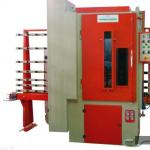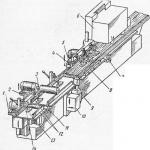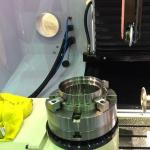How to make a DNA model from ordinary materials. Molecules from plasticine
The fact that substances consist of separate smallest particles, people guessed for a very long time, this was stated by the Greek scientist Democritus about 2500 years ago.
But if in ancient times scientists only assumed that substances consist of separate particles, then at the beginning of the 20th century the existence of such particles was proved by science. The particles that make up many substances are called molecules 1.
A molecule of a substance is the smallest particle of that substance. The smallest particle of water is a water molecule, the smallest particle of sugar is a sugar molecule, and so on.
What are the sizes of the molecules?
It is known that a lump of sugar can be crushed into very small grains, a grain of wheat can be ground into flour. Oil, spreading over water, forms a film, the thickness of which is 40,000 times less than the thickness of a human hair. But in a grain of flour and in the thickness of the oil film there are not one, but many molecules. This means that the size of the molecules of these substances is even smaller than the size of a grain of flour and the thickness of the film. The following comparison can be made: a molecule is as many times smaller than an average-sized apple as an apple is smaller than a terrestrial globe.
Molecules of different substances differ from each other in size, but they are all very small. Modern instruments - electron microscopes - made it possible to see and photograph the largest of the molecules (see color insert II). These photographs are another confirmation of the existence of molecules.
Since the molecules are very small, each body contains a great many of them. 1 cm 3 of air contains such a number of molecules that if you add up the same number of grains of sand, you get a mountain that will close a large factory.
In nature, all bodies differ from each other at least in some way. No people have the same faces. Among the leaves growing on the same tree, no two are exactly the same. Even in a whole heap of sand, we will not find the same grains of sand. Millions of balls for bearings are manufactured at the factory in one sample, the same size. But if the balls are measured more accurately than it was done during processing, then you can be sure that there are no two identical ones among them.
Do molecules of the same substance differ from each other?
1. Molecule - Latin word, means "small mass".
Numerous and complex experiments have shown that the molecules of the same substance are the same. Each pure substance consists of the same molecules, inherent only to it. This is an amazing fact. It is impossible, for example, to distinguish water obtained from juice or milk from water obtained by the distillation of sea water, since the molecules of water are the same and no other substance consists of the same molecules.
Although molecules are very small particles of matter, they are also divisible. The particles that make up molecules are called atoms.
For example, an oxygen molecule consists of two identical atoms. A water molecule consists of three atoms - one oxygen atom and two hydrogen atoms. Figure 14 shows two water molecules. Such a schematic representation of molecules is accepted in science, it corresponds to the properties of molecules studied in physical experiments, and is called a model of a molecule.
The fission of two water molecules produces four hydrogen atoms and two oxygen atoms. Every two hydrogen atoms combine into a hydrogen molecule, and oxygen atoms - into an oxygen molecule, as shown schematically in Figure 15.
Atoms are not indivisible particles either, they are made up of smaller particles called elementary particles.
Questions. 1. What are the particles that make up matter called? 2. From what observations does it follow that the sizes of molecules are small? 3. What do you know about molecular sizes? 4. What do you know about the composition of the water molecule? 5. What experiments and reasoning show that all water molecules are the same?
Exercise. As you know, drops of an oily liquid spread over the surface of the water, forming a thin film. Why does the oil stop spreading at a certain film thickness?
Exercise. Make models of two water molecules from colored plasticine. Then use these molecules to make models of oxygen and hydrogen molecules.
This work is carried out with students who came to receive vocational education. Very often, their knowledge of chemistry is weak, so there is no interest in the subject. But every student has a desire to learn. Even a poorly performing student shows interest in the subject when he manages to do something himself.
Tasks in the work are compiled taking into account gaps in knowledge. Rolling theoretical material allows you to quickly remember the necessary concepts, which helps students to complete the work. Having built models of molecules, it is easier for children to write structural formulas. For stronger students who complete the practical part of the work faster, calculation tasks are given. Each student achieves results when doing work: some manage to build molecular models, which they do with pleasure, others do most of the work, others do all the tasks, and each student receives an assessment.
Lesson Objectives:
- formation of independent work skills;
- generalize and systematize students' knowledge about the theory of the structure of organic compounds;
- consolidate the ability to draw up structural formulas of hydrocarbons;
- develop the skills to give names according to international nomenclature;
- repeat the solution of problems to determine the mass fraction of an element in a substance;
- develop attention and creativity;
- develop logical thinking;
- develop a sense of responsibility.
Practical work
“Making models of molecules of organic substances.
Compilation of structural formulas of hydrocarbons”.
Goal of the work:
- Learn how to make models of molecules of organic substances.
- Learn to write down the structural formulas of hydrocarbons and name them according to international nomenclature.
theoretical material. Hydrocarbons are organic compounds made up of carbon and hydrogen atoms. The carbon atom in all organic compounds is tetravalent. Carbon atoms can form straight, branched, closed chains. The properties of substances depend not only on the qualitative and quantitative composition, but also on the order in which atoms are connected to each other. Substances that have the same molecular formula but different structures are called isomers. Prefixes indicate the amount di- two, three- three, tetra- four; cyclo- means closed.
Suffixes in the name of hydrocarbons indicate the presence of a multiple bond:
en single bond between carbon atoms (C C);
en double bond between carbon atoms (C=C);
in triple bond between carbon atoms (C C);
diene two double bonds between carbon atoms (C = C C = C);
Radicals: methyl-CH 3 ; ethyl -C 2 H 5 ; chlorine-Cl; bromine -Br.
Example. Make a model of the propane molecule.
propane molecule C 3 H 8 contains three carbon atoms and eight hydrogen atoms. The carbon atoms are connected to each other. Suffix – en indicates the presence of a single bond between carbon atoms. The carbon atoms are at an angle of 10928 minutes.
The molecule has the shape of a pyramid. Draw carbon atoms as black circles, hydrogen atoms as white circles, and chlorine atoms as green circles.
When depicting models, observe the ratio of the sizes of atoms.

We find the molar mass using the periodic table
M (C 3 H 8) \u003d 12 3 + 1 8 \u003d 44 g / mol.
To name a hydrocarbon, you need:
- Choose the longest chain.
- Number, starting from the edge closest to the radical or multiple bond.
- Indicate the radical if several radicals each indicate. (number before title).
- Name the radical starting with the smallest radical.
- Name the longest chain.
- Specify the position of the multiple bond. (The number after the name).

When compiling formulas by name necessary:
- Determine the number of carbon atoms in the chain.
- Determine the position of the multiple bond. (The number after the name).
- Determine the position of the radicals. (number before title).
- Write down the formulas of the radicals.
- Lastly, determine the number and arrange the hydrogen atoms.
The mass fraction of an element is determined by the formula:
![]() Where
Where
is the mass fraction of a chemical element;
n is the number of atoms of a chemical element;
Ar is the relative atomic mass of a chemical element;
Mr is the relative molecular weight.
When solving a problem, apply calculation formulas:
Relative gas density Dg shows how many times the density of one gas is greater than the density of another gas. D(H 2) - relative density for hydrogen. D(air) - relative density in air.
Equipment: A set of ball-and-stick models of molecules, plasticine of different colors, matches, the table “Ultimate hydrocarbons”, the periodic table. Individual assignments.
Progress. Completing assignments by choice.
Option number 1.
Task number 1 . Make models of molecules: a) butane, b) cyclopropane. Sketch the molecular models in your notebook. Write the structural formulas of these substances. Find their molecular weights.

Task number 3. Compose structural formulas of substances:
a) butene-2, write its isomer;
b) 3,3 - dimethylpentine-1.
Task number 4. Solve problems:
Task 1 Determine the mass fraction of carbon and hydrogen in methane.
Problem 2. Soot is used to make rubber. Determine how many g of soot (C) can be obtained by decomposing 22 g of propane?
Option number 2.
Task number 1 . Make models of molecules: a) 2-methylpropane, b) cyclobutane. Sketch the molecular models in your notebook. Write the structural formulas of these substances. Find their molecular weights.
Task number 2. Name the substances:

Task number 3 Compose structural formulas of substances:
a) 2-methylbutene-1, write its isomer;
b) propine.
Task number 4. Solve problems:
Task 1. Determine the mass fraction of carbon and hydrogen in ethylene.
Problem 2. Soot is used to make rubber. Determine the mass of soot (C) that can be obtained by decomposing 36 g of pentane?
Option number 3.
Task number 1 . Make models of molecules: a) 1,2-dichloroethane, b) methylcyclopropane
Sketch the molecular models in your notebook. Write the structural formulas of these substances. Determine how many times dichloroethane is heavier than air?
Task number 2. Name the substances:

Task number 3. Compose structural formulas of substances:
a) 2-methylbutene-2 write its isomer;
b) 3,4-dimethylpentine-1.
Task number 4. Solve problems:
Task 1. Find the molecular formula of a substance containing 92.3% carbon and 7.7% hydrogen. The relative density for hydrogen is 13.
Task 2. What volume of hydrogen will be released during the decomposition of 29 g of butane (n.o.)?
Option number 4.
Task number 1 . Make models of molecules: a) 2,3-dimethylbutane, b) chlorocyclopropane. Sketch the molecular models in your notebook. Write the structural formulas of these substances. Find their molecular weights.
Task number 2. Name the substances

Task number 3. Compose structural formulas of substances:
a) 2-methibutadiene-1,3; write the isomer.
b) 4-methylpentine-2.
Task number 4. Solve problems:
Task 1. Find the molecular formula of a substance containing 92.3% carbon and 7.7% hydrogen. The relative density for hydrogen is 39.
Task 2. What volume of carbon dioxide will be released during the complete combustion of 72 g of propane motor fuel?
Today we will hold a lesson not only in modeling, but also in chemistry, and we will make models of molecules from plasticine. Plasticine balls can be represented as atoms, and ordinary matches or toothpicks will help to show structural bonds. This method can be used by teachers when explaining new material in chemistry, by parents when checking and studying homework, and by children themselves who are interested in the subject. There is probably no easier and more accessible way to create visual material for the mental visualization of micro-objects.
Representatives of the world of organic and inorganic chemistry are presented here as an example. By analogy with them, other structures can be implemented, the main thing is to understand all this diversity.
Materials for work:
- plasticine of two or more colors;
- structural formulas of molecules from the textbook (if necessary);
- matches or toothpicks.
1. Prepare plasticine for sculpting spherical atoms that will form molecules, as well as matches - to represent the bonds between them. Naturally, it is better to show atoms of different sorts in a different color, so that it is clearer to imagine a specific object of the microworld.
2. To make balls, pinch off the required number of portions of plasticine, knead in your hands and roll the figures in your palms. For sculpting organic hydrocarbon molecules, you can use larger red balls - this will be carbon, and smaller blue ones - hydrogen.

3. To mold a methane molecule, insert four matches into the red ball so that they are directed to the vertices of the tetrahedron.

4. Put blue balls on the free ends of the matches. The natural gas molecule is ready.

5. Prepare two identical molecules to explain to the child how to get the molecule of the next representative of hydrocarbons - ethane.

6. Connect the two models by removing one match and two blue balls. Ethan is ready.

7. Next, continue the exciting lesson and explain how the formation of a multiple bond occurs. Remove the two blue balls and make the bond between the carbons double. In a similar way, you can blind all the hydrocarbon molecules necessary for occupation.

8. The same method is suitable for sculpting the molecules of the inorganic world. The same plasticine balls will help to carry out the plan.

9. Take the central carbon atom - the red ball. Insert two matches into it, setting the linear shape of the molecule, attach two blue balls to the free ends of the matches, which in this case represent oxygen atoms. Thus, we have a linear carbon dioxide molecule.

10. Water is a polar liquid, and its molecules are angular formations. They are made up of one oxygen atom and two hydrogen atoms. The angular structure is determined by the lone pair of electrons on the central atom. It can also be depicted as two green dots.

These are such fascinating creative lessons that you should definitely practice with children. Students of any age will become interested in chemistry, they will better understand the subject if, in the process of studying, they are provided with a visual aid made by their own hands.

Many students do not like chemistry and consider it a boring subject. Many find this subject difficult. But its study can be interesting and informative if you approach the process creatively and show everything clearly.
We offer you a detailed guide to sculpting molecules from plasticine.
Before making molecules, we need to decide in advance which chemical formulas we will use. In our case, this is ethane, ethylene, methylene. We will need: plasticine of contrasting colors (in our case, red and blue) and a little green plasticine, matches (toothpicks).
1. From red plasticine we roll 4 balls with a diameter of about 2 cm (carbon atoms). Then we roll 8 smaller balls from blue plasticine, about a centimeter in diameter (hydrogen atoms).

2. We take 1 red ball and insert 4 matches (or toothpicks) into it as shown in the figure.

3. We take 4 blue balls and put them on the free ends of the matches inserted into the red ball. The result is a molecule of natural gas.

4. Repeat step #3 and get two molecules for the next chemical.

5. The made molecules must be connected with each other with a match in order to get an ethane molecule.

6. You can also create a molecule with a double bond - ethylene. To do this, from each molecule obtained in step No. 3, we take out 1 match with a blue ball put on it and connect the parts together with two matches.


7. We take a red ball and 2 blue ones and connect them together with two matches so that we get a chain: blue - 2 matches - red - 2 matches - blue. We have another molecule with a double bond - methylene.

8. We take the remaining balls: red and 2 blue and connect them with matches to each other as shown in the figure. Then we roll 2 small balls from green plasticine and attach them to our molecule. We have a molecule with two negatively charged electrons.

The study of chemistry will become more interesting, and your child will have an interest in the subject.

If you find an error, please highlight a piece of text and click Ctrl+Enter.
In addition to observation and experiment, modeling plays an important role in the knowledge of the natural world and chemistry.
We have already said that one of the main goals of observation is to look for patterns in the results of experiments.
However, some observations are inconvenient or impossible to conduct directly in nature. The natural environment is recreated in the laboratory with the help of special instruments, installations, objects, i.e. models (from Latin modulus - measure, sample). In models, only the most important features and properties of the object are copied.
For example, in order to study the natural phenomenon of lightning, scientists did not have to wait for a thunderstorm. Lightning can be modeled in physics class and in the school lab. Two metal balls need to be given opposite electric charges: positive and negative. When the balls approach to a certain distance, a spark jumps between them - this is lightning in miniature. The greater the charge on the balls, the earlier the spark jumps when approaching, the longer the artificial lightning. Such lightning is obtained using a special device called an electrophore machine (Fig. 33).
Rice. 33.
electrophore machine
Studying the model allowed scientists to determine that natural lightning is a giant electrical discharge between two thunderclouds or between clouds and the ground. However, a real scientist seeks to find a practical application for each phenomenon studied. The more powerful the electric lightning, the higher its temperature. But the conversion of electrical energy into heat can be used, for example, for welding and cutting metals. This is how the process of electric welding, familiar to every student today, appeared (Fig. 34).

Rice. 34.
The natural phenomenon of lightning can be simulated in the laboratory
Modeling in physics is used especially widely. In the lessons on this subject, you will get acquainted with a variety of models that will help you study electrical and magnetic phenomena, the laws of motion of bodies, and optical phenomena.
Each natural science uses its own models that help visualize a real natural phenomenon or object.
The most famous geographical model is the globe (Fig. 35, a) - a miniature three-dimensional image of our planet, with which you can study the location of continents and oceans, countries and continents, mountains and seas. If the image of the earth's surface is applied to a flat sheet of paper, then such a model is called a geographical map (Fig. 35, b).

Rice. 35.
The most famous geographic models: a - globe; b - map
Models are widely used in the study of biology. Suffice it to mention, for example, models - dummies of human organs, etc. (Fig. 36).

Rice. 36.
Biological models: a - eye; b - brain
Modeling is no less important in chemistry. Conventionally, chemical models can be divided into two groups: subject and sign or symbolic (Scheme 1).

Subject models of atoms, molecules, crystals, chemical industrial plants are used for greater clarity.
You have probably seen an image of a model of an atom, reminiscent of the structure of the solar system (Fig. 37).

Rice. 37.
Model of the structure of the atom
Ball-and-stick or volumetric models are used to model chemical molecules. They are assembled from balls symbolizing individual atoms. The difference lies in the fact that in the ball-and-rod models the atoms-balls are located at a certain distance from each other and are fastened to each other by rods. For example, the ball-and-stick and volumetric models of water molecules are shown in Figure 38.

Rice. 38.
Models of the water molecule: a - ball-and-rod; b - volumetric
Models of crystals resemble ball-and-stick models of molecules, however, they do not depict individual molecules of a substance, but show the mutual arrangement of particles of a substance in a crystalline state (Fig. 39).

Rice. 39.
Copper crystal model
However, most often chemists use not subject, but sign or symbolic models. These are chemical symbols, chemical formulas, equations of chemical reactions.
You will start studying the chemical language of signs and formulas in the next lesson.
Questions and tasks
- What is a model? modeling?
- Give examples of: a) geographic models; b) physical models; c) biological models.
- What models are used in chemistry?
- Make ball-and-stick and three-dimensional models of the water molecule from plasticine. What shape are these molecules?
- Write down the cruciferous flower formula if you studied this plant family in biology class. Can this formula be called a model?
- Write down an equation for calculating the speed of a body if you know the path and time it takes the body to travel. Can this equation be called a model?




